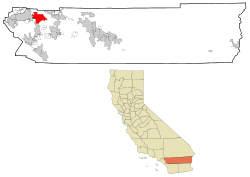Moreno Valley, California
| Moreno Valley, California | |||
|---|---|---|---|
| General law city | |||
| City of Moreno Valley | |||

Man-made lake in the Sunnymead Ranch community of northern Moreno Valley
|
|||
|
|||
| Nickname(s): "MoVal" | |||
| Motto: "People, Pride, Progress!" | |||
 Location in Riverside County and the state of California |
|||
| Location in the United States | |||
| Coordinates: 33°56′35″N 117°13′42″W / 33.94306°N 117.22833°WCoordinates: 33°56′35″N 117°13′42″W / 33.94306°N 117.22833°W | |||
| Country | |||
| State |
|
||
| County |
|
||
| Incorporated | December 3, 1984 | ||
| Government | |||
| • Type | Council-Manager | ||
| • City council | Jesse L. Molina Jeffery Giba George E. Price Yxstian Gutierrez D. LaDonna Jempson |
||
| Area | |||
| • Total | 51.475 sq mi (133.319 km2) | ||
| • Land | 51.275 sq mi (132.800 km2) | ||
| • Water | 0.200 sq mi (0.519 km2) 0.39% | ||
| Elevation | 1,631 ft (497 m) | ||
| Population (April 1, 2010) | |||
| • Total | 193,365 | ||
| • Estimate (2013) | 201,175 | ||
| • Rank |
2nd in Riverside County 21st in California 112th in the United States |
||
| • Density | 3,800/sq mi (1,500/km2) | ||
| Time zone | Pacific (UTC−8) | ||
| • Summer (DST) | PDT (UTC−7) | ||
| ZIP codes | 92551–92557 | ||
| Area codes | 909, 951 | ||
| FIPS code | 06-49270 | ||
| GNIS feature IDs | 1668251, 2411159 | ||
| Website | www |
||
Moreno Valley is a city located in Riverside County, California and is part of the San Bernardino-Riverside Metropolitan Area. A relatively young city, its rapid growth from the 1980s to the early 2000s made it the second-largest city in Riverside County by population, and one of the Inland Empire's population centers. As of the 2010 census, the city's population was 193,365. The city is closely tied to Riverside, California, the county seat and largest city in the county, which neighbors Moreno Valley directly to the west. Moreno Valley is also part of the Greater Los Angeles area.
The Moreno Valley area was first inhabited 2,300 years ago. There are at least 190 prehistoric archaeological locations within the city. The majority of the sites are milling stations - where chaparral seed was the dominant milling activity. Rock art, consisting of pictographs, and petroglyphs are present - though most of the petroglyphs in Moreno Valley consist of boulders with "cupules", or cup-shaped holes pecked into them.
Spanish scouts initially came across descendants of the Shoshone, and Luiseño tribes; although other groups, such as the Serrano and Cahuilla were in the area. The late prehistoric Luiseño and Cahuilla were semi-sedentary, meaning that they wintered in villages, then spread out in family groups during the spring and summer months to harvest seeds and acorns.
Spanish scouts blazed a number of trails in the area, including the Anza Trail, which runs through the Edgemont area of present-day Moreno Valley.
...
Wikipedia



